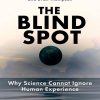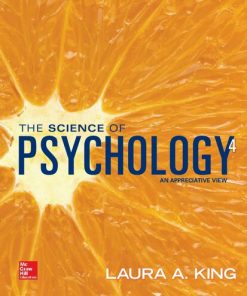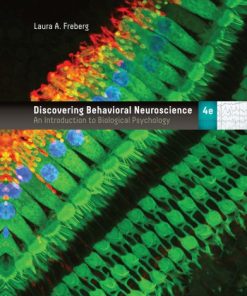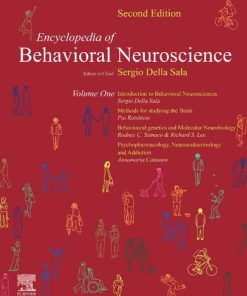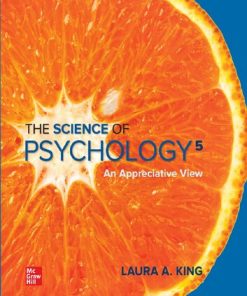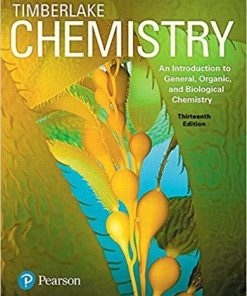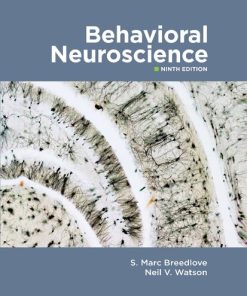(EBook PDF) Discovering Behavioral Neuroscience An Introduction to Biological Psychology 4th Edition by Laura Freberg 9798214341644 full chapters
$50.00 Original price was: $50.00.$25.00Current price is: $25.00.
Discovering Behavioral Neuroscience: An Introduction to Biological Psychology 4th Edition by Laura A. Freberg – Ebook PDF Instant Download/DeliveryISBN: 9798214341644
Full download Discovering Behavioral Neuroscience: An Introduction to Biological Psychology 4th Edition after payment.
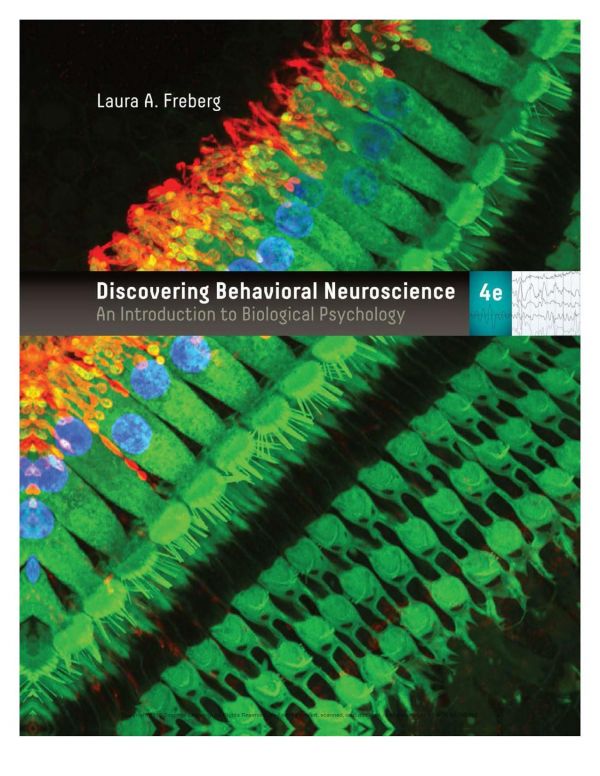
Product details:
ISBN-13 : 9798214341644
Author: Laura Freberg
Do you have a strong science background? Or do you feel overwhelmed at the prospect of taking a behavioral neuroscience, biological psychology, or physiological psychology course? Either way, this text’s clear writing, interesting examples, learning aids, and illustrations will keep you interested and on track. DISCOVERING BEHAVIORAL NEUROSCIENCE: AN INTRODUCTION TO BIOLOGICAL PSYCHOLOGY, 4th Edition includes classic concepts, current topics, and cutting-edge research to provide you with a foundational understanding of the structure and function of the nervous system and its relationship to both typical and disordered human behavior. You’ll learn about the most current thinking in behavioral neuroscience while honing your critical thinking skills to prepare yourself for the future.
Discovering Behavioral Neuroscience: An Introduction to Biological Psychology 4th Table of contents:
Chapter 1. What Is Behavioral Neuroscience?
Neuroscience as an Interdisciplinary Field
Historical Highlights in Neuroscience
Ancient Milestones in Understanding the Nervous System
The Dawn of Scientific Reasoning
Modern Neuroscience Begins
Behavioral Neuroscience Research Methods
Microscopic Methods
Imaging
Recording
Brain Stimulation
Lesion
Biochemical Methods
Genetic Methods
Research Ethics in Behavioral Neuroscience
Human Participant Guidelines
Animal Subjects Guidelines
Thought Questions
Key Terms
Chapter 2. Functional Neuroanatomy and the Evolution of the Nervous System
Anatomical Directions and Planes of Section
Protecting and Supplying the Nervous System
Meninges
Cerebrospinal Fluid
The Brain’s Blood Supply
The Central Nervous System
The Spinal Cord
Embryological Divisions of the Brain
The Hindbrain
The Midbrain
The Forebrain
The Peripheral Nervous System
The Cranial Nerves
The Spinal Nerves
The Autonomic Nervous System
The Endocrine System
The Evolution of the Human Nervous System
Natural Selection and Evolution
Evolution of the Nervous System
Evolution of the Human Brain
Thought Questions
Key Terms
Chapter 3. Neurophysiology: The Structure and Functions of the Cells of the Nervous System
Glia and Neurons
Glia
The Structure of Neurons
Structural Variations in Neurons
Functional Variations in Neurons
Generating Action Potentials
The Ionic Composition of the Intracellular and Extracellular Fluids
The Movement of Ions
The Resting Potential
The Action Potential
Propagating Action Potentials
The Synapse
Gap Junctions
Chemical Synapses
Axo-axonic Synapses
Thought Questions
Key Terms
Chapter 4. Psychopharmacology
Neurotransmitters, Neuromodulators, and Neurohormones
Identifying Neurochemicals
Types of Neurochemicals
Mechanisms of Neuropharmacology
Agonists and Antagonists
Production of Neurochemicals
Neurochemical Storage
Neurochemical Release
Receptor Effects
Reuptake and Enzymatic Degradation
Basic Principles of Drug Effects
Administration of Drugs
Individual Differences in Responses to Drugs
Placebo Effects
Tolerance and Withdrawal
Addiction
Effects of Selected Psychoactive Drugs
Stimulants
Opioids
Cannabis
LSD
Alcohol
Thought Questions
Key Terms
Chapter 5. Genetics and the Development of the Human Brain
The Genetic Bases of Behavior
From Genome to Trait
Sources of Genetic Variability
Heritability
Epigenetics
Building a Brain
Prenatal Development
Effects of Experience on Development
Disorders of Nervous System Development
The Brain Across the Lifespan
Brain Changes during Adolescence and Adulthood
Adult Neurogenesis
Healthy Brain Aging
Thought Questions
Key Terms
Chapter 6. Vision
From Sensation to Perception
The Visual Stimulus: Light
The Advantages of Light as a Stimulus
The Electromagnetic Spectrum
Light Interacts with Objects
The Structure and Functions of the Visual System
Protecting the Eye
The Functional Anatomy of the Eye
The Layered Organization of the Retina
The Photoreceptors
Processing by Retinal Interneurons
Optic Nerve Connections
The Striate Cortex
Visual Analysis beyond the Striate Cortex
Visual Perception
Hierarchies
Spatial Frequencies
The Perception of Depth
Coding Color
The Life-Span Development of the Visual System
Disorders of the Visual System
Amblyopia
Cataracts
Visual Acuity Problems
Blindness
Visual Agnosias
Thought Questions
Key Terms
Chapter 7. Nonvisual Sensation and Perception
Audition
Sound as a Stimulus
The Structure and Function of the Auditory System
Auditory Perception
Hearing Disorders
The Body Senses
The Vestibular System
Touch
Pain
The Chemical Senses
Olfaction
Gustation
Synaesthesia
Thought Questions
Key Terms
Chapter 8. Movement
Muscles
Types of Muscles
Muscle Anatomy and Contraction
The Effects of Exercise on Muscle
The Effects of Aging on Muscles
Neural Control of Muscles
Alpha Motor Neurons
The Motor Unit
The Control of Muscle Contractions
The Control of Spinal Motor Neurons
Reflex Control of Movement
Reciprocal Inhibition at Joints
The Flexor Reflex
Spinal Reflexes Related to Walking
Reflexes over the Lifespan
Motor Systems of the Brain
Spinal Motor Pathways
The Cerebellum
The Basal Ganglia
The Motor Cortex
Disorders of Movement
Toxins
Myasthenia Gravis
Muscular Dystrophy
Polio
Accidental Spinal Cord Injury (SCI)
Amyotrophic Lateral Sclerosis (ALS; Lou Gehrig’s Disease)
Parkinson’s Disease
Huntington’s Disease
Thought Questions
Key Terms
Chapter 9. Homeostasis, Motivation, and Reward
Homeostasis and Motivation
Regulating Body Temperature
Adaptations Maintain Temperature
Endothermic Responses to Heat and Cold
Deviations in Human Core Temperature
Brain Mechanisms for Temperature Regulation
Thirst: Regulating the Body’s Fluid Levels
Intracellular and Extracellular Fluid Compartments
Osmosis Causes Water to Move
The Kidneys
The Sensation of Thirst
Hunger: Regulating the Body’s Supply of Nutrients
The Process of Digestion
The Pancreatic Hormones
The Initiation of Eating
Satiety
Healthy and Disordered Eating
Defining Healthy Weight
Obesity
Disordered Eating
Pleasure and Reward
Multiple Facets of Reward
Reward Pathways
The Neurochemistry of Reward
Cortical Processing of Reward
Thought Questions
Key Terms
Chapter 10. Sexual Behavior
Sexual Development
The Genetics of Sex
Three Stages of Prenatal Development
Development at Mini-puberty
Development at Puberty
Sex Differences in Hormones, Brain Structure, and Behavior
The Organizing Role of Sex Hormones
The Organizing Role of Sex Chromosome Genes
Sexual Dimorphism in the Brain
Sex Differences in Behavior and Cognition
Sexual Orientation
Hormones and Sexual Orientation
Brain Structure and Sexual Orientation
Genes and Sexual Orientation
Sexual Orientation and Cognition
Biological Influences on Adult Sexual Behavior
The Regulation of Sex Hormones
Mood, Menstruation, and Childbirth
Hormones and Adult Sexual Behavior
Attraction, Romantic Love, Sexual Desire, and Parenting
Elements of Physical Attractiveness
Romantic Love and Sexual Desire
Reproduction and Parenting
Sexual Dysfunction and Its Treatment
Thought Questions
Key Terms
Chapter 11. Sleep and Waking
Biorhythms
Individual Variations in Sleep Patterns
Shift Work, Jet Lag, and Daylight Saving Time
The Body’s Internal Clocks Manage Circadian Rhythms
Major Depressive Disorder with Seasonal Pattern
Neural Correlates of Waking and Sleep
Electroencephalogram Recordings of Waking and Sleep
Brain Networks Control Waking and Sleep
Biochemical Correlates of Waking and Sleep
The Functions of Sleep
Changes in Sleep over the Lifetime
Possible Advantages of Sleep
Special Benefits of REM Sleep
The Possible Functions of Dreaming
Sleep–Wake Disorders
Insomnia
Narcolepsy
Breathing-Related Sleep Disorders
Sudden Infant Death Syndrome (SIDS)
Sleep Talking and Sleep Walking
REM Sleep Behavior Disorder
Restless Legs Syndrome (RLS)
Thought Questions
Key Terms
Chapter 12. Learning and Memory
Categorizing Learning and Memory
Types of Learning
Types of Memory
Mechanisms of Synaptic Plasticity
Learning in Simple Organisms
Long-Term Potentiation (LTP)
Working Memory
Memory Consolidation
Reactivation and Reconsolidation
Neural Systems Supporting Learning and Memory
Early Efforts to Locate Memory Functions
Systems Supporting Classical Conditioning
The Temporal Lobe and Episodic Memory
Semantic Memory Networks
Systems Supporting Working Memory
Systems Supporting Procedural Memory
The Effects of Stress and Healthy Aging on Learning and Memory
Stress Effects on Memory
The Effects of Healthy Aging on Memory
Thought Questions
Key Terms
Chapter 13. Cognitive Neuroscience
Understanding Cognitive Neuroscience
Hemispheric Asymmetry and Its Behavioral Correlates
Learning About Asymmetry
The Evolution of Lateralization
The Development of Lateralization
Implications of Asymmetry for Behavior
Language
The Origins of Language
Communication in Nonhuman Animals
Multilingualism
American Sign Language (ASL)
Communication Disorders and Brain Mechanisms for Language
Paul Broca and Patient Tan
Aphasia
Disorders of Reading and Writing
Stuttering
Intelligence
Assessing Intelligence
Intelligence and Genetics
Structural and Functional Correlates of Intelligence
The Neuroscience of Decision Making
Thought Questions
Key Terms
Chapter 14. Emotion, Aggression, and Stress
Emotion
The Evolution and Adaptive Benefits of Emotion
Theories of Emotion
The Expression and Recognition of Emotion
Biological Correlates of Emotion
Emotion Regulation
Social Cognition
Aggression and Violence
Genetics, Environment, Epigenetics, and Aggression
Brain Structures and Aggression
Biochemistry and Aggression
Stress
Hans Selye and the General Adaptation Syndrome (GAS)
Responses to Stress
Stress and Epigenetics
Stress, the Immune System, and Health
Thought Questions
Key Terms
Chapter 15. Neuropsychology
What Is Neuropsychology?
Who Are the Neuropsychologists?
Neuropsychological Assessment
Neurocognitive Disorders
Alzheimer’s Disease
Vascular Disease (Stroke)
Traumatic Brain Injury (TBI)
Substance/Medication-Induced Neurocognitive Disorder
HIV-Associated Neurocognitive Disorder (HAND)
Prion Diseases
Neurocognitive Disorders Due to Other Medical Conditions
Brain Tumors
Infections
Epilepsy
Multiple Sclerosis
Migraine
Recovery and Treatment in Neurocognitive Disorders
Plasticity and Recovery
Cognitive Reserve
Rehabilitation for Neurocognitive Disorders
Thought Questions
Key Terms
Chapter 16. Psychopathology
What Does It Mean to Have a Mental Disorder?
Autism Spectrum Disorder (ASD)
Causes of ASD
Brain Structure and Function in ASD
Treatment of ASD
Attention Deficit Hyperactivity Disorder (ADHD)
Causes of ADHD
Brain Structure and Function in ADHD
Treatment of ADHD
Schizophrenia
Genetic Contributions to Schizophrenia
Environmental Influences on Schizophrenia
Brain Structure and Function in Schizophrenia
The Biochemistry of Schizophrenia
Treating Schizophrenia
Bipolar Disorder
Genetics and Bipolar Disorder
Brain Structure and Function in Bipolar Disorder
Biochemistry and Treatment of Bipolar Disorder
Major Depressive Disorder (MDD)
Genetic Contributions to MDD
Environmental Influences on MDD
Brain Structure and Function in MDD
Biochemistry of MDD
Treatment of MDD
Anxiety Disorders
Obsessive-Compulsive Disorder (OCD)
Posttraumatic Stress Disorder (PTSD)
Brain Structure and Activity in PTSD
Biochemistry and Treatment of PTSD
Antisocial Personality Disorder (ASPD)
Genetics and ASPD
Brain Structure and Function in ASPD
People also search for Discovering Behavioral Neuroscience: An Introduction to Biological Psychology 4th:
discovering behavioral neuroscience 5th edition
discovering behavioral neuroscience 4th edition
discovering behavioral neuroscience author laura freberg
discovering behavioral neuroscience pdf
discovering behavioral neuroscience 5th edition pdf
Tags:
Discovering,Behavioral Neuroscience,Introduction,Biological Psychology,Laura Freberg
You may also like…
Psychology - Clinical Psychology
Engineering - Mechanical Engineering & Dynamics
Politics & Philosophy - Social Sciences
Medicine - Neuroscience
Encyclopedia of Behavioral Neuroscience 2nd Edition by Sergio Della Sala 0128196416 978-0128196410
History & Research
History & Research
Introduction to Research Methods in Psychology 4th Edition Dennis Howitt
Uncategorized
(Original PDF) Chemistry: An Introduction to General, Organic, and Biological Chemistry 13th Edition
Relationships & Lifestyle - Diet & Nutrition


